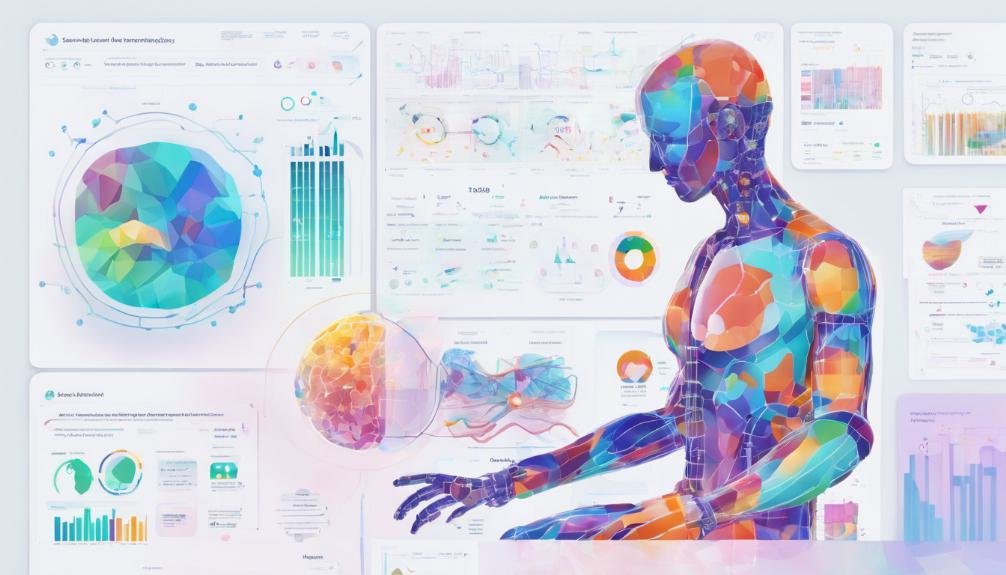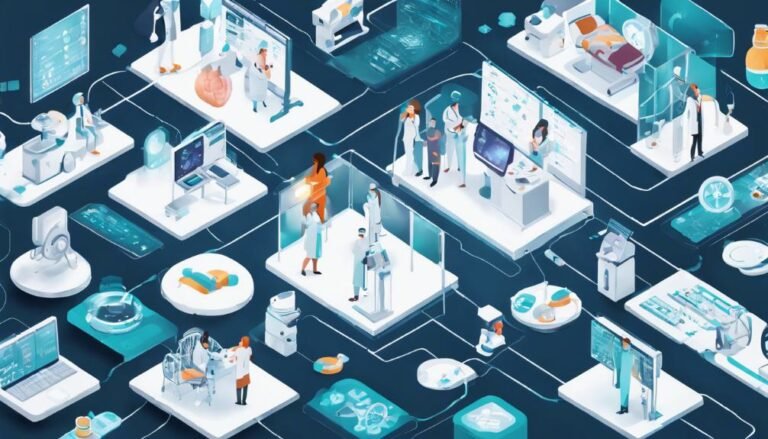AI in Health Data Visualization
In the domain of healthcare, AI is reshaping the landscape of data visualization by offering innovative solutions to navigate the complexities of medical information. Imagine a scenario where intricate patient data is transformed into clear, actionable insights at a fraction of the time it would take through conventional methods. This streamlined approach not only streamlines decision-making but also opens up new possibilities for personalized care strategies. The intersection of AI and health data visualization holds immense potential, but what challenges and ethical considerations lie ahead in this transformative journey?
Key Takeaways
- AI enhances health data visualization for informed decision-making.
- Machine learning identifies patterns and anomalies in vast health data.
- Predictive analytics aid in forecasting health outcomes based on data analysis.
- Smart visualization tools offer dynamic user experiences with AI integration.
- Personalized medicine analyzes genetic, clinical, and lifestyle data for tailored treatment strategies.
The Role of AI in Healthcare
AI plays a critical role in revolutionizing healthcare by enhancing decision-making processes and improving patient outcomes. Predictive analytics, a key component of AI in healthcare, enables healthcare providers to anticipate potential health issues in patients based on historical data and trends. This proactive approach allows for early intervention and personalized treatment plans tailored to individual patients' needs.
Personalized medicine is another significant area where AI excels. By analyzing vast amounts of genetic, clinical, and lifestyle data, AI helps healthcare professionals develop personalized treatment strategies that consider each patient's unique characteristics. This individualized approach leads to more effective treatments, minimizing adverse effects and optimizing outcomes.
In essence, AI's integration in healthcare through predictive analytics and personalized medicine is reshaping the industry by shifting towards a more proactive, patient-centered model. By leveraging AI technologies, healthcare providers can enhance their decision-making processes, improve patient outcomes, and ultimately deliver more precise and efficient care.
Enhancing Data Analysis With AI
You can harness AI-driven insights to uncover patterns and trends within complex health datasets.
Smart visualization tools powered by AI can help you transform raw data into meaningful and easily interpretable graphics.
AI-Driven Insights
By leveraging artificial intelligence, data analysis in health visualization is being revolutionized, allowing for deeper insights and more accurate interpretations of complex datasets. AI-driven predictions play an essential role in providing personalized insights that cater to individual needs and health conditions.
Through advanced algorithms and machine learning techniques, AI can analyze vast amounts of health data swiftly, identifying patterns and correlations that may not be apparent to the human eye.
AI-driven insights enable healthcare professionals to make more informed decisions, leading to improved patient outcomes and proactive intervention strategies. Personalized insights generated by AI algorithms help in tailoring treatment plans to specific patient profiles, enhancing the efficacy of healthcare interventions.
Additionally, AI can detect anomalies in health data, signaling potential health risks or deviations from normal patterns, prompting timely interventions and preventive measures.
Smart Visualization Tools
Utilizing cutting-edge technology, smart visualization tools revolutionize data analysis by seamlessly integrating artificial intelligence to enhance insights and interpretations in health visualization. These tools offer a dynamic user experience, allowing healthcare professionals to interact with data in a more intuitive and efficient manner.
By leveraging AI algorithms, smart visualization tools enable real-time adjustments and personalized displays based on user interactions, enhancing the overall visual analytics experience.
Through the application of AI, these tools can identify patterns, trends, and anomalies within complex health datasets, empowering users to extract valuable insights quickly and accurately. The integration of AI algorithms also enables predictive capabilities, assisting in forecasting potential health outcomes and trends based on historical data analysis.
Improved Decision Making
AI algorithms play a pivotal role in enhancing data analysis for improved decision making in health visualization. By leveraging predictive analytics, AI can process vast amounts of health data to identify patterns and trends that may not be apparent through traditional methods. This capability enables healthcare professionals to make more informed decisions regarding patient care and outcomes.
Through the use of predictive analytics, AI systems can forecast potential clinical outcomes based on a variety of factors such as patient history, demographics, and treatment plans. This predictive capability not only helps in identifying high-risk patients who may require immediate attention but also aids in developing personalized treatment strategies for better patient care.
Benefits of Health Data Visualization
Health data visualization offers a vital and thorough way to present complex medical information, aiding in better decision-making and understanding for healthcare professionals. Through visual communication, data interpretation becomes more accessible, allowing healthcare providers to quickly grasp trends, patterns, and outliers within large datasets. This enhanced understanding of health data can lead to improved health outcomes for patients as decisions are based on a detailed analysis of visualized information.
Moreover, health data visualization promotes patient engagement by presenting information in a visually appealing and easy-to-understand format. Patients can better comprehend their health status, treatment plans, and progress through interactive graphs, charts, and dashboards. This not only empowers patients to actively participate in their healthcare journey but also enables them to make informed decisions regarding their well-being.
In essence, the benefits of health data visualization extend beyond just facilitating decision-making; they play a significant role in enhancing patient engagement, improving health outcomes, and fostering a more efficient healthcare system.
Challenges in Implementing AI
Implementing AI in the healthcare sector poses various challenges that necessitate careful consideration and strategic planning. Some significant hurdles include implementation barriers, data accuracy, regulatory hurdles, and training requirements.
Implementation barriers arise due to the complex nature of healthcare systems, requiring seamless integration of AI technologies with existing infrastructure.
Ensuring data accuracy is pivotal as inaccurate or incomplete data can lead to flawed insights and decisions. This challenge necessitates robust data collection, cleaning, and validation processes to maintain the integrity of AI-driven analytics.
Regulatory hurdles present another challenge, as healthcare data is highly sensitive and subject to strict privacy regulations. Compliance with laws such as HIPAA adds an extra layer of complexity to AI implementation in healthcare.
Additionally, meeting the training requirements for healthcare professionals to effectively utilize AI tools is essential. Proper training ensures that healthcare workers can interpret AI-generated insights accurately and incorporate them into decision-making processes.
Addressing these challenges is essential for successful AI implementation in health data visualization.
Improving Decision-Making Processes
Improving decision-making processes in healthcare through advanced data visualization techniques is essential for optimizing patient outcomes and operational efficiency. By leveraging predictive analytics, healthcare professionals can enhance their ability to make informed decisions regarding clinical outcomes and treatment effectiveness. These analytics enable the identification of patterns and trends within patient data, offering insights that aid in predicting potential outcomes and guiding treatment strategies.
Moreover, utilizing data visualization tools in population health management allows for a thorough understanding of health trends and patterns within specific demographics. This information is vital for healthcare providers to develop targeted interventions and programs that address the unique needs of various populations, ultimately improving overall health outcomes at a broader level.
Future Trends in Healthcare Visualization
You'll explore the upcoming trends in healthcare visualization, focusing on AI-enhanced medical imaging and interactive patient dashboards.
These developments hold the potential to revolutionize how medical professionals interpret and communicate complex data, leading to more informed decision-making processes.
Embracing these advancements can pave the way for enhanced patient care and improved health outcomes.
Ai-Enhanced Medical Imaging
In the field of healthcare visualization, the integration of artificial intelligence into medical imaging stands as a pivotal advancement with promising future trends. AI has greatly enhanced diagnostic accuracy in medical imaging through its sophisticated machine learning applications. By leveraging vast amounts of patient data, AI algorithms can quickly analyze images to detect abnormalities, assist in early disease identification, and provide more precise treatment recommendations. This has revolutionized medical imaging processes, leading to faster and more accurate diagnoses, ultimately improving patient outcomes.
AI's ability to learn from patterns and continually refine its algorithms has enabled medical professionals to interpret images with greater efficiency and reliability. Additionally, AI-enhanced medical imaging has the potential to reduce human error, enhance workflow efficiency, and optimize resource allocation in healthcare settings.
As technology continues to evolve, the seamless integration of AI into medical imaging is poised to redefine the future landscape of healthcare visualization, offering unprecedented insights and advancements in patient care.
Interactive Patient Dashboards
With the rapid evolution of healthcare visualization technologies, the integration of interactive patient dashboards emerges as a prominent future trend reshaping the landscape of patient-centered care delivery. These dashboards offer a dynamic platform for patient engagement, enabling users to interact with their health data in real-time.
By incorporating elements of visual storytelling, interactive patient dashboards facilitate a deeper level of data interpretation, allowing patients to comprehend complex medical information more intuitively.
The emphasis on user experience in interactive patient dashboards enhances the overall accessibility and usability of health data, empowering individuals to take an active role in managing their well-being. Through personalized visualizations and interactive features, patients can track their progress, set goals, and make informed decisions regarding their healthcare journey.
This level of transparency and empowerment fosters a collaborative relationship between patients and healthcare providers, ultimately leading to improved health outcomes and a more seamless care experience.
Ethical Considerations in AI
Ethical considerations play a pivotal role in the integration of artificial intelligence (AI) within health data visualization systems. When discussing AI in health data visualization, addressing AI bias and guaranteeing transparency in algorithms are essential. AI bias refers to the unintentional prejudice that can occur in AI systems due to skewed data or underlying assumptions. It's essential to mitigate bias in AI algorithms to ensure fair and accurate outcomes for all patients.
Transparency in algorithms is equally important as it allows healthcare providers and patients to understand how AI systems make decisions. By providing transparency, individuals can trust the AI-driven insights and recommendations, fostering a more ethical environment in healthcare. Ensuring that AI algorithms are transparent and free from bias promotes fairness, accountability, and ultimately enhances the credibility and effectiveness of AI in health data visualization systems.
As AI continues to advance in healthcare, maintaining ethical standards will be fundamental in harnessing its full potential for improving patient outcomes and healthcare delivery.
AI Applications in Medical Imaging
AI applications have revolutionized medical imaging by enhancing diagnostic accuracy and efficiency. Through the use of AI algorithms and machine learning, medical professionals can now analyze complex medical images with greater precision and speed. These AI algorithms are trained on vast amounts of data, enabling them to recognize patterns and abnormalities that may not be easily detected by the human eye.
Machine learning techniques, particularly image recognition, have enabled significant advancements in medical imaging. By leveraging large datasets, AI can assist in the early detection of diseases such as cancer, cardiovascular conditions, and neurological disorders.
The ability of AI to process and interpret images rapidly has led to quicker diagnosis and treatment planning for patients.
Data Security and Privacy Concerns
Data security and privacy concerns arise as AI applications in health data visualization continue to advance, prompting the need for robust safeguards and regulations. With the vast amount of sensitive patient information being processed and analyzed by AI algorithms, ensuring data encryption is vital to protect against unauthorized access. Implementing strong encryption methods can help safeguard data both at rest and in transit, reducing the risk of breaches and ensuring confidentiality.
Moreover, obtaining user consent plays a pivotal role in addressing privacy concerns. Users should have a clear understanding of how their data is being used and shared within AI-powered health data visualization systems. Transparent consent mechanisms empower individuals to make informed decisions about the collection and utilization of their personal health information, fostering trust between users and healthcare providers.
Conclusion
To sum up, AI in health data visualization marks a significant paradigm shift, driving healthcare towards precision and innovation.
By harnessing advanced analytics and artificial intelligence, healthcare professionals can reveal valuable insights from intricate data, improving patient care and operational efficiency.
Despite challenges and ethical considerations, the future of healthcare visualization holds great promise for revolutionizing the way we analyze, interpret, and utilize data to drive better outcomes.
Embrace the evolving landscape of AI in healthcare for unprecedented advancements in patient-centered care.







